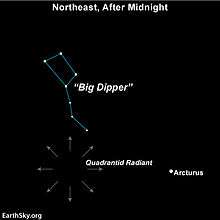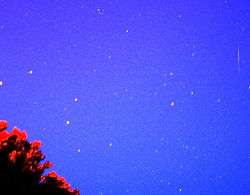Quadrantids
| Quadrantids (QUA) | |
|---|---|
|
Quadrantid meteor (right) seen at twilight | |
| Discovery date | 1820s[1] |
| Parent body | 2003 EH1 |
| Radiant | |
| Constellation | Boötes |
| Right ascension | 15h 28m[2] |
| Declination | +50°[2] |
| Properties | |
| Occurs during | January 1–6[2] |
| Date of peak | January 3[2] |
| Velocity | 41[3] km/s |
| Zenithal hourly rate | 120 [4] |
The Quadrantids (QUA) are a January meteor shower. The zenithal hourly rate (ZHR) of this shower can be as high as that of two other reliably rich meteor showers, the Perseids in August and the Geminids in December,[4] yet Quadrantid meteors are not seen as often as meteors in these other two showers, because the peak intensity is exceedingly sharp, sometimes lasting only hours.
General information
The meteor rates exceed one-half of their highest value for only about eight hours (compared to two days for the August Perseids), which means that the stream of particles that produces this shower is narrow, and apparently deriving within the last 500 years from some orbiting body.[5] The parent body of the Quadrantids was tentatively identified in 2003 by Peter Jenniskens[6] as the minor planet 2003 EH1, which in turn may be related to the comet C/1490 Y1[7] that was observed by Chinese, Japanese and Korean astronomers some 500 years ago.

The radiant point of this shower is an area inside the constellation Boötes, not far from the Big Dipper. It lies between the end of the handle of the Big Dipper and the quadrilateral of stars marking the head of the constellation Draco.[5] This meteor shower is best seen in the northern hemisphere, but it can be seen to 51 degrees south latitude.[8]
The name comes from Quadrans Muralis, a former constellation created in 1795 by the French astronomer Jérôme Lalande that is now part of Boötes. In early January 1825, Antonio Brucalassi in Italy reported that “the atmosphere was traversed by a multitude of the luminous bodies known by the name of falling stars.”[1] They appeared to radiate from Quadrans Muralis. In 1839, Adolphe Quetelet of Brussels Observatory in Belgium and Edward C. Herrick in Connecticut independently made the suggestion that the Quadrantids are an annual shower.[9]
In 1922, the International Astronomical Union (IAU) devised a list of 88 modern constellations. The list was agreed upon by the IAU at its inaugural general assembly held in Rome in May 1922.[10] It did not include a constellation Quadrans Muralis. The IAU officially adopted this list in 1930,[11] but this meteor shower still retains the name Quadrantids, for the original and now-obsolete constellation.
| Year | Quadrantids active during | Peak of shower | ZHRmax |
|---|---|---|---|
| 2008 | Jan. 1–5 | Jan. 4 | 82[12] |
| 2009 | Jan. 1–5 | Jan. 3 | 146[13] |
| 2010 | Waning gibbous Moon[14] (full Moon on Dec. 31)[15] | ||
| 2011 | Dec. 28 – Jan. 12 | Jan. 3 | 90[16] |
| 2012 | Dec. 28 – Jan. 12 | Jan. 4 | 83[17] |
| 2013 | Jan. 3 Waning gibbous Moon (full Moon on Dec. 28)[18] | 137[19][20] | |
| 2014 | Jan. 4 Main peak with ZHRmax=245 between Jan. 3 17:00 UT and 22:30 UT; isolated brief spike of ZHRmax=315 Jan. 4 at 18:00 UT | 315[21] | |
| 2016 | [22] |
See also
References
- 1 2 "Quadrantids". meteorshowersonline.com. Retrieved 2012-12-29.
- 1 2 3 4 Moore, Patrick; Rees, Robin (2011), Patrick Moore's Data Book of Astronomy (2nd ed.), Cambridge University Press, p. 275, ISBN 0521899354.
- ↑ Millman, Peter M.; McKinley, D. W. R. (December 1953), "The Quadrantid Meteor Shower", Journal of the Royal Astronomical Society of Canada, 47: 237, Bibcode:1953JRASC..47..237M.
- 1 2 "Does the published meteor rate for a shower really represent what I should expect to see?". American Meteor Society. Retrieved 2012-12-29.
- 1 2 "Stellar Meteor Shower Jan. 3". Space.com. Retrieved 2009-01-03.
- ↑ Peter Jenniskens (Dec 8, 2003). "2003 EH1 is the Quadrantid shower parent comet". The Ephemeris (San Jose Astronomical Association newsletter). Retrieved 2004-12-17.
- ↑ Jenniskens, Peter (2004). "2003 EH1 Is the Quadrantid Shower Parent Comet". The Astronomical Journal. 127 (5): 3018–3022. Bibcode:2004AJ....127.3018J. doi:10.1086/383213.
- ↑ "Quadrantid meteor shower". NASA Meteor Watch on Facebook. 2012-12-26. Retrieved 2012-12-29.
- ↑ "Everything you need to know: Quadrantid meteor shower". EarthSky. Retrieved 2012-12-29.
- ↑ "The IAU list of the 88 constellations and their abbreviations". ianridpath.com. Retrieved 2012-12-29.
- ↑ "IAU and the 88 Constellations". iau.org. Retrieved 2012-12-29.
- ↑ Quadrantids 2008: visual data quicklook
- ↑ Quadrantids 2009: visual data quicklook
- ↑ IMO Meteor Shower Calendar 2010: January to March
- ↑ U.S. Naval Observatory Phases of the Moon 2009
- ↑ Quadrantids 2011: visual data quicklook
- ↑ Quadrantids 2012: visual data quicklook
- ↑ U.S. Naval Observatory Phases of the Moon 2012
- ↑ Quadrantids 2013: visual data quicklook
- ↑ 2013 Quadrantid Shower (Chris L Peterson @ Cloudbait Observatory)
- ↑ Quadrantids 2014: visual data quicklook
- ↑ Worldwide viewing times for the 2016 Quadrantids meteor shower
External links
- Worldwide viewing times for the 2016 Quadrantids meteor shower
- Quadrantids Create Year's First Meteor Shower (NASA 01.02.12)
- International Meteor Organization 2010 Meteor Shower Calendar
- NASA Quadrantid Airborne Campaign
- Meteorblog.com
